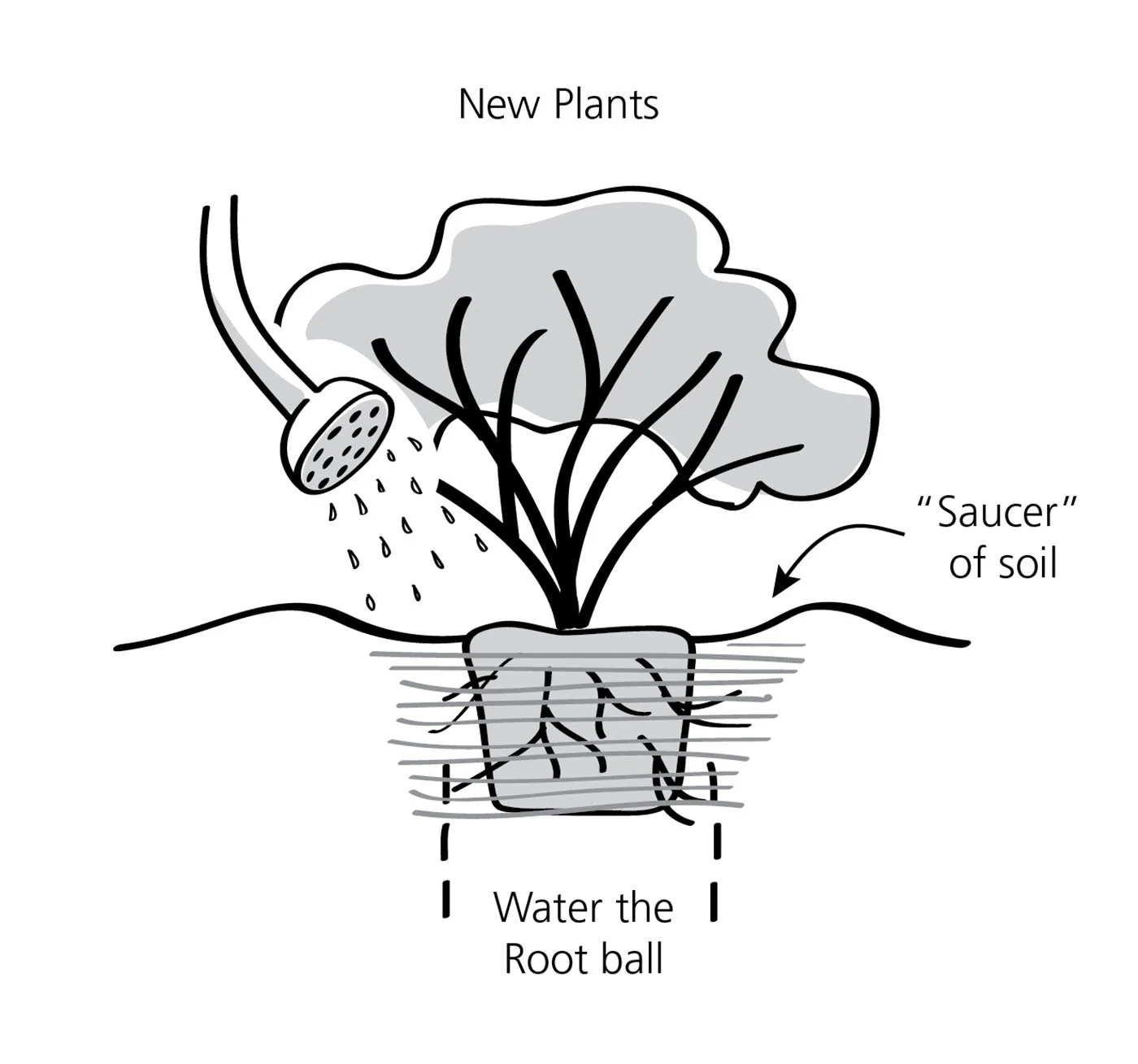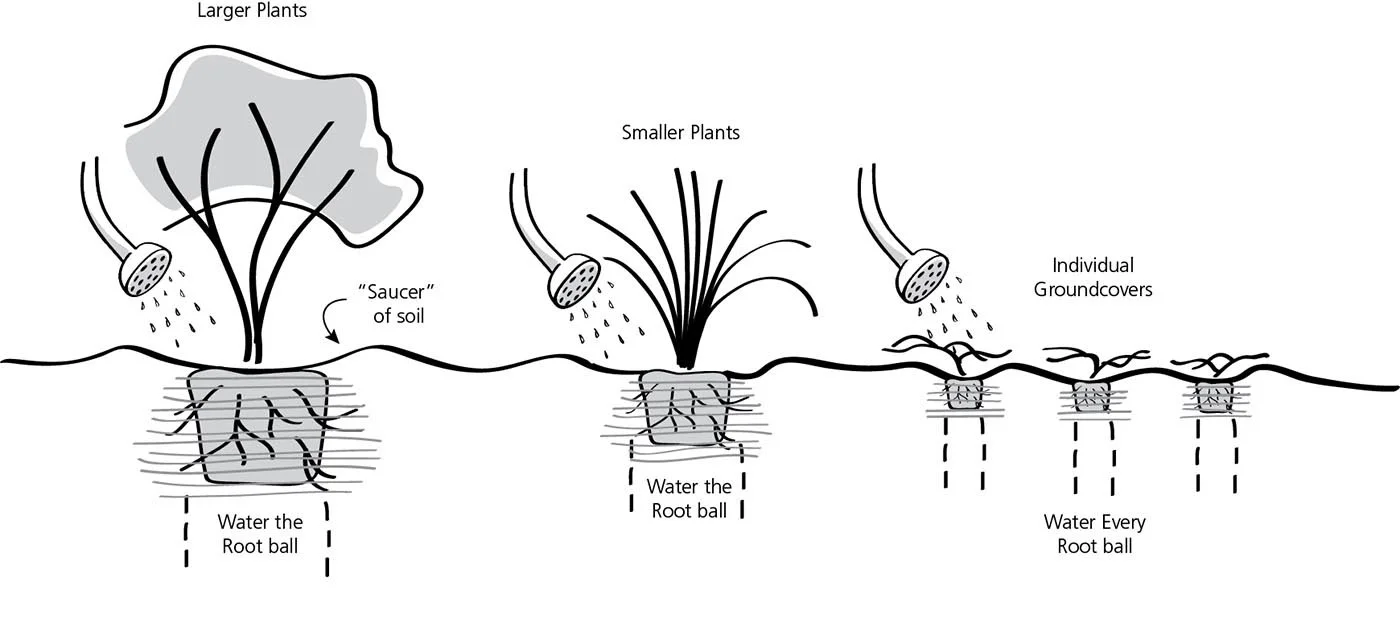Editor's Note: This post gives you in-depth information on how best to water. For a quick refresher, see also our NW Gardening Tips care sheet, Watering 101.
Do you know what the No. 1 cause of poor health or death of plants (especially new plantings) is? It's not disease. Not unexpected freezes. Not mistakes made during planting.
Watering, you say???
Ahh, you read the title of this post — yes, it's insufficient or incorrect watering. These living organisms you've just planted can be delicate and demanding, and neglecting their water needs, even briefly, can undo all your hard work getting them planted.
The very simplified rule is this: For each and every plant, water the soil where the roots actually are right now, make sure that the root zone (entire width & depth) gets saturated, and let it dry out a bit before watering it again.
There are exceptions, of course, for variations in soil, rainfall, and types of plants (some prefer extremely dry or wet soil), but this rule covers the majority, and virtually all new plantings.
Gabriel Maki, Swansons' tree & shrub buyer, is working to remove some of the fear and mystery from the art of proper watering. He periodically leads a seminar at the nursery entitled, "Watering Plants in the Pacific NW," which includes four main points to make watering simpler and more effective (and maybe even less work!).
1. Keep up watering during most of the growing season (April to October).
This may seem obvious, but Gabriel describes the paradox that surprises many new gardeners here: "The Puget Sound region has a 'Mediterranean' climate: most of our precipitation is in winter, when the plants don't necessarily need it. We have some of the driest summers in the U.S.!" Most plants need that supplemental water when they are actively growing, typically between April and October. This is especially critical during the first year or two for new plantings.
2. Make sure the roots are actually getting the water.
It's fun and easy to pass a summer evening in the garden with a drink in one hand and a hose in the other, giving your plants a nice shower. But how much of that water is actually getting to the roots? You might assume the water is trickling down through the leaves, and "wicking" over to your plants' root zone from the surrounding soil a foot away. Both assumptions may be fatally wrong.
Why not water from overhead? Gabriel explains that, "when water is added overhead, as in with rain or an overhead sprinkler, the foliage can act as an umbrella, and the root ball can remain dry." So it's important to make sure the soil over the root zone is getting a thorough soaking. That may require spraying your water under the rest of the plant onto the soil surface (also a good practice to minimize many plant diseases).
Note: a watering wand can greatly help you get the water where it's needed. See our tool discussion at the end of this post.
Why not water the surrounding soil and assume soil is "wicking" (traveling horizontally through the soil) to the root ball? Gabriel says, "If you add water only to the surrounding soil of a newly installed plant, and that plant has roots still contained within a root ball of a different soil type, water will not wick into the root ball very well."
Porous soils (such as sandy soils) especially do not wick water well. If you water to one side of a plant, the water may just seep downward, and not horizontally to the rest of the roots.
For new plants, it's a good idea to mound up soil or mulch in a "saucer" over the root zone to hold water in place to soak in, rather than running off the surface. On a slope, it's easy for runoff to occur, so mounding or creating some type of temporary "dam" may be necessary.
So, for new plants, water the root ball (for container and ball & burlap plants), rather than the soil surrounding the outside of the root ball. For bare root and more established plants, water the soil over the whole root zone, at least as wide as the "dripline" (the area under the spread of the branches). Most established plants (especially trees) actually extend their roots significantly beyond their dripline, so you can water an even wider zone, if feasible.
How do you water a bunch of newly planted little plants, such as a large array of groundcover starts? "The same way we water any other newly installed plants," Gabriel says. "Water [all] the root balls." Running sprinklers over the whole area might not sufficiently reach all the new roots.
A couple of additional points about soil wicking:
• Think of soil that has been allowed to dry out as a dry sponge— it's difficult to get it wet with one spray of water. The water just rolls off of the sponge until eventually it starts to get saturated. Similarly, you may need to water dry soil very slowly to make sure the water is starting to absorb and soak in.
• Different types of soils do not wick water between them, so if you plant in a layer of fluffy organic soil over compacted native soil, it's best to break up and incorporate the edges of the planting hole as much as possible.
3. Don't overwater — make sure the roots get oxygen as well as water.
You will often hear us say: water deeply and infrequently. Keeping the soil wet all the time doesn't allow enough air for the roots to "breathe," and rot or disease can set in. For most plants, it's best to let the soil surface dry a bit, to allow that. As Gabriel puts it, "Water deeply and thoroughly, so that you are sure there is sufficient water for the roots; then you can let the surface dry out a bit without dehydrating the plant."
How long to wait before you water again? A day? A week? Again, there are variations in soil, rainfall, and types of plants, so it's wise to check, rather than assume. You can use a soil moisture meter to be sure, but you can also test it with your finger an inch or two down (perhaps deeper for a large tree or shrub). If the soil feels moist to the touch, it's best to wait a day or two (or three) before watering again.
There may be other cues to soil dryness. For container plants, you can check how heavy a pot is to lift right after watering vs. after drying for a couple of days. You might also notice when your plant is just starting to wilt. With experience, you'll learn what's a typical interval for watering your particular plant or location.
4. Encourage roots to grow as deep as possible.
For most plants, the deeper the roots, the more resilient the plant, especially for tolerating stresses such as drought. This goes for everything from big trees to lawns. Again, there are variables, but generally deep, infrequent watering is a key way to encourage deep roots.
Watering systems and tools:
Using the right system or tool can make you a lot more successful in getting water effectively to the roots. Gabriel Maki's watering seminar also discusses various options. We briefly outline them here.
1. Irrigation zones: if you are using automatic irrigation, it's important to plan the system in zones, which apply water in specific rates needed for shrubs, groundcovers, lawns, etc.
2. Soaker hoses: an inexpensive and good way to make sure water slowly soaks in to root zones.
3. Drip irrigation: a good method to conserve water and customize watering rates for specific plants.
4. Sprinklers: best to use these only for lawns and bedding plants (see overhead watering issues above).
5. Watering bags, such as Tree Gators®: good for new tree plantings where you can't easily reach a hose, but they might require supplemental watering of the root zone on more established trees.
6. Watering wands: a simple, effective way to get water where the plant needs it (such as under the branches, mentioned in #2 above). Helps conserve water in the process.
Sing it again with us: For each and every plant, water the soil where the roots actually are right now, make sure that the root zone (entire width & depth) gets saturated, and let it dry out a bit before watering it again.
And don't forget mulching which also greatly helps conserve soil moisture and slows down surface runoff.
As with all our advice, we hope these principles help you grow into a successful and passionate Northwest gardener! Don't hesitate to send your questions our way.




